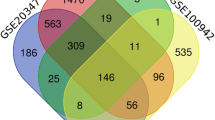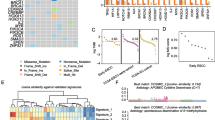Abstract
Mounting evidence has demonstrated that PPM1D participates in the development and progression of a wide variety of tumors. However, its precise roles in esophageal squamous cell carcinoma (ESCC) remain under investigation. Here, UALCAN, an interactive web-portal to perform the expression analyses of PPM1D using TCGA gene expression data, and PPM1D high expression was exhibited in primary esophageal cancer. Further investigation revealed that PPM1D expression was obviously higher in ESCC tissues than in normal tissues (P < 0.01), which was consistent with the results from real-time qPCR and Western blotting in ESCC tissues and paired normal esophageal tissues. Besides, PPM1D expression was closely correlated with TNM staging, tumor differentiation and lymph node metastasis (P < 0.01), but not related to the patients’ gender and age (P > 0.05). Notably, PPM1D expression in metastatic ESCC patients was markedly higher than that in non-metastatic ESCC patients (P < 0.01), and the ESCC patients with high PPM1D expression predicted poor prognosis. Multivariate assay demonstrated that PPM1D and lymph node metastasis were considered as independent prognostic factors for the ESCC patients. These findings suggest PPM1D plays a pivotal important role in onset and progression of ESCC, and may be a new biomarker for metastasis and prognosis of the ESCC patients.




Similar content being viewed by others
References
Ferlay J, Shin HR, Bray F, Forman D, Mathers C, Parkin DM (2010) Estimates of worldwide burden of cancer in 2008: GLOBOCAN 2008. Int J Cancer 127:2893–2917. https://doi.org/10.1002/ijc.25516
Jemal A, Center MM, DeSantis C, Ward EM (2010) Global patterns of cancer incidence and mortality rates and trends. Cancer Epidemiol Biomark Prev 19:1893–1907. https://doi.org/10.1158/1055-9965.EPI-10-0437
Wang Z, Tang L, Sun G, Tang Y, Xie Y, Wang S, Hu X, Gao W, Cox SB, Wang JS (2006) Etiological study of esophageal squamous cell carcinoma in an endemic region: a population-based case control study in Huaian, China. BMC Cancer 6:287. https://doi.org/10.1186/1471-2407-6-287
Khuroo MS, Zargar SA, Mahajan R, Banday MA (1992) High incidence of oesophageal and gastric cancer in Kashmir in a population with special personal and dietary habits. Gut 33:11–15
Mahboubi E, Kmet J, Cook PJ, Day NE, Ghadirian P, Salmasizadeh S (1973) Oesophageal cancer studies in the Caspian Littoral of Iran: the Caspian cancer registry. Br J Cancer 28:197–214
Torre LA, Bray F, Siegel RL, Ferlay J, Lortet-Tieulent J, Jemal A (2015) Global cancer statistics, 2012. CA Cancer J Clin 65:87–108. https://doi.org/10.3322/caac.21262
van Hagen P, Hulshof MC, van Lanschot JJ, Steyerberg EW, van Berge Henegouwen MI, Wijnhoven BP, Richel DJ, Nieuwenhuijzen GA, Hospers GA, Bonenkamp JJ, Cuesta MA, Blaisse RJ, Busch OR, ten Kate FJ, Creemers GJ, Punt CJ, Plukker JT, Verheul HM, Spillenaar Bilgen EJ, van Dekken H, van der Sangen MJ, Rozema T, Biermann K, Beukema JC, Piet AH, van Rij CM, Reinders JG, Tilanus HW, van der Gaast A (2012) Preoperative chemoradiotherapy for esophageal or junctional cancer. N Engl J Med 366:2074–2084. https://doi.org/10.1056/NEJMoa1112088
Cunningham D, Allum WH, Stenning SP, Thompson JN, Van de Velde CJ, Nicolson M, Scarffe JH, Lofts FJ, Falk SJ, Iveson TJ, Smith DB, Langley RE, Verma M, Weeden S, Chua YJ, Participants MT (2006) Perioperative chemotherapy versus surgery alone for resectable gastroesophageal cancer. N Engl J Med 355:11–20. https://doi.org/10.1056/NEJMoa055531
Vousden KH, Lu X (2002) Live or let die: the cell's response to p53. Nat Rev Cancer 2:594–604. https://doi.org/10.1038/nrc864
Levine AJ (1997) p53, the cellular gatekeeper for growth and division. Cell 88:323–331
Chen J (2016) The cell-cycle arrest and apoptotic functions of p53 in tumor initiation and progression. Cold Spring Harb Perspect Med 6. https://doi.org/10.1101/cshperspect.a026104
Zhu YH, Zhang CW, Lu L, Demidov ON, Sun L, Yang L, Bulavin DV, Xiao ZC (2009) Wip1 regulates the generation of new neural cells in the adult olfactory bulb through p53-dependent cell cycle control. Stem Cells 27:1433–1442. https://doi.org/10.1002/stem.65
Fiscella M, Zhang H, Fan S, Sakaguchi K, Shen S, Mercer WE, Vande Woude GF, O'Connor PM, Appella E (1997) Wip1, a novel human protein phosphatase that is induced in response to ionizing radiation in a p53-dependent manner. Proc Natl Acad Sci U S A 94:6048–6053
Choi J, Appella E, Donehower LA (2000) The structure and expression of the murine wildtype p53-induced phosphatase 1 (Wip1) gene. Genomics 64:298–306. https://doi.org/10.1006/geno.2000.6134
Li J, Yang Y, Peng Y, Austin RJ, van Eyndhoven WG, Nguyen KC, Gabriele T, McCurrach ME, Marks JR, Hoey T, Lowe SW, Powers S (2002) Oncogenic properties of PPM1D located within a breast cancer amplification epicenter at 17q23. Nat Genet 31:133–134. https://doi.org/10.1038/ng888
Bulavin DV, Demidov ON, Saito S, Kauraniemi P, Phillips C, Amundson SA, Ambrosino C, Sauter G, Nebreda AR, Anderson CW, Kallioniemi A, Fornace AJ Jr, Appella E (2002) Amplification of PPM1D in human tumors abrogates p53 tumor-suppressor activity. Nat Genet 31:210–215. https://doi.org/10.1038/ng894
Nannenga B, Lu X, Dumble M, Van Maanen M, Nguyen TA, Sutton R, Kumar TR, Donehower LA (2006) Augmented cancer resistance and DNA damage response phenotypes in PPM1D null mice. Mol Carcinog 45:594–604. https://doi.org/10.1002/mc.20195
Wu B, Guo BM, Kang J, Deng XZ, Fan YB, Zhang XP, Ai KX (2016) PPM1D exerts its oncogenic properties in human pancreatic cancer through multiple mechanisms. Apoptosis 21:365–378. https://doi.org/10.1007/s10495-015-1211-4
Kozakai Y, Kamada R, Kiyota Y, Yoshimura F, Tanino K, Sakaguchi K (2014) Inhibition of C-terminal truncated PPM1D enhances the effect of doxorubicin on cell viability in human colorectal carcinoma cell line. Bioorg Med Chem Lett 24:5593–5596. https://doi.org/10.1016/j.bmcl.2014.10.093
Yang H, Gao XY, Li P, Jiang TS (2015) PPM1D overexpression predicts poor prognosis in non-small cell lung cancer. Tumour Biol 36:2179–2184. https://doi.org/10.1007/s13277-014-2828-6
Wang W, Zhu H, Zhang H, Zhang L, Ding Q, Jiang H (2014) Targeting PPM1D by lentivirus-mediated RNA interference inhibits the tumorigenicity of bladder cancer cells. Braz J Med Biol Res 47:1044–1049
Liu S, Qi L, Han W, Wan X, Jiang S, Li Y, Xie Y, Liu L, Zeng F, Liu Z, Zu X (2014) Overexpression of wip1 is associated with biologic behavior in human clear cell renal cell carcinoma. PLoS One 9:e110218. https://doi.org/10.1371/journal.pone.0110218
Richter M, Dayaram T, Gilmartin AG, Ganji G, Pemmasani SK, Van Der Key H, Shohet JM, Donehower LA, Kumar R (2015) WIP1 phosphatase as a potential therapeutic target in neuroblastoma. PLoS One 10:e0115635. https://doi.org/10.1371/journal.pone.0115635
Peng TS, He YH, Nie T, Hu XD, Lu HY, Yi J, Shuai YF, Luo M (2014) PPM1D is a prognostic marker and therapeutic target in colorectal cancer. Exp Ther Med 8:430–434. https://doi.org/10.3892/etm.2014.1762
Chandrashekar DS, Bashel B, Balasubramanya SAH, Creighton CJ, Ponce-Rodriguez I, Chakravarthi B, Varambally S (2017) UALCAN: a portal for facilitating tumor subgroup gene expression and survival analyses. Neoplasia 19:649–658. https://doi.org/10.1016/j.neo.2017.05.002
Liu Y, Li K, Ren Z, Li S, Zhang H, Fan Q (2012) Clinical implication of elevated human cervical cancer oncogene-1 expression in esophageal squamous cell carcinoma. J Histochem Cytochem 60:512–520. https://doi.org/10.1369/0022155412444437
Liu HT, Wang N, Wang X, Li SL (2010) Overexpression of Pim-1 is associated with poor prognosis in patients with esophageal squamous cell carcinoma. J Surg Oncol 102:683–688. https://doi.org/10.1002/jso.21627
Lu Z, Liu H, Xue L, Xu P, Gong T, Hou G (2008) An activated Notch1 signaling pathway inhibits cell proliferation and induces apoptosis in human esophageal squamous cell carcinoma cell line EC9706. Int J Oncol 32:643–651
Lu X, Nguyen TA, Moon SH, Darlington Y, Sommer M, Donehower LA (2008) The type 2C phosphatase Wip1: an oncogenic regulator of tumor suppressor and DNA damage response pathways. Cancer Metastasis Rev 27:123–135. https://doi.org/10.1007/s10555-008-9127-x
Lambros MB, Natrajan R, Geyer FC, Lopez-Garcia MA, Dedes KJ, Savage K, Lacroix-Triki M, Jones RL, Lord CJ, Linardopoulos S, Ashworth A, Reis-Filho JS (2010) PPM1D gene amplification and overexpression in breast cancer: a qRT-PCR and chromogenic in situ hybridization study. Mod Pathol 23:1334–1345. https://doi.org/10.1038/modpathol.2010.121
Tan DS, Lambros MB, Rayter S, Natrajan R, Vatcheva R, Gao Q, Marchio C, Geyer FC, Savage K, Parry S, Fenwick K, Tamber N, Mackay A, Dexter T, Jameson C, McCluggage WG, Williams A, Graham A, Faratian D, El-Bahrawy M, Paige AJ, Gabra H, Gore ME, Zvelebil M, Lord CJ, Kaye SB, Ashworth A, Reis-Filho JS (2009) PPM1D is a potential therapeutic target in ovarian clear cell carcinomas. Clin Cancer Res 15:2269–2280. https://doi.org/10.1158/1078-0432.CCR-08-2403
Hofstetter W, Swisher SG, Correa AM, Hess K, Putnam JB Jr, Ajani JA, Dolormente M, Francisco R, Komaki RR, Lara A, Martin F, Rice DC, Sarabia AJ, Smythe WR, Vaporciyan AA, Walsh GL, Roth JA (2002) Treatment outcomes of resected esophageal cancer. Ann Surg 236:376–384; discussion 384-5. https://doi.org/10.1097/01.SLA.0000027925.23604.5C
Urschel JD, Vasan H, Blewett CJ (2002) A meta-analysis of randomized controlled trials that compared neoadjuvant chemotherapy and surgery to surgery alone for resectable esophageal cancer. Am J Surg 183:274–279
Zhang H, Chen W, Duan CJ, Zhang CF (2013) Overexpression of HSPA2 is correlated with poor prognosis in esophageal squamous cell carcinoma. World J Surg Oncol 11:141. https://doi.org/10.1186/1477-7819-11-141
Li GB, Zhang XL, Yuan L, Jiao QQ, Liu DJ, Liu J (2013) Protein phosphatase magnesium-dependent 1delta (PPM1D) mRNA expression is a prognosis marker for hepatocellular carcinoma. PLoS One 8:e60775. https://doi.org/10.1371/journal.pone.0060775
Hirasawa A, Saito-Ohara F, Inoue J, Aoki D, Susumu N, Yokoyama T, Nozawa S, Inazawa J and Imoto I (2003) Association of 17q21-q24 gain in ovarian clear cell adenocarcinomas with poor prognosis and identification of PPM1D and APPBP2 as likely amplification Targets Clin Cancer Res 9:1995–2004
Author information
Authors and Affiliations
Corresponding author
Rights and permissions
About this article
Cite this article
Li, K., Liu, Y., Xu, S. et al. PPM1D Functions as Oncogene and is Associated with Poor Prognosis in Esophageal Squamous Cell Carcinoma. Pathol. Oncol. Res. 26, 387–395 (2020). https://doi.org/10.1007/s12253-018-0518-1
Received:
Accepted:
Published:
Issue Date:
DOI: https://doi.org/10.1007/s12253-018-0518-1




